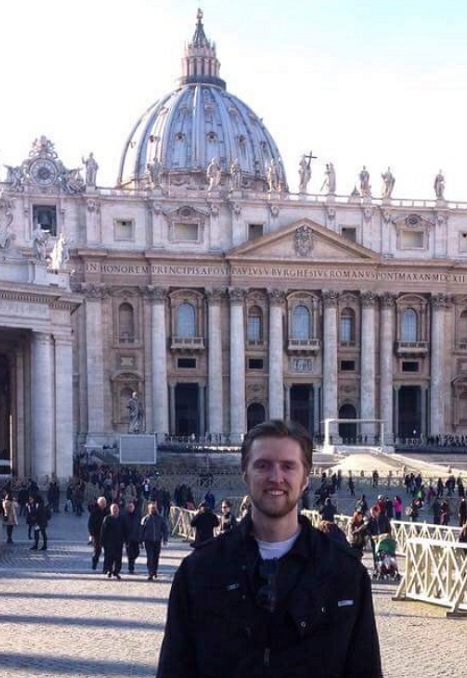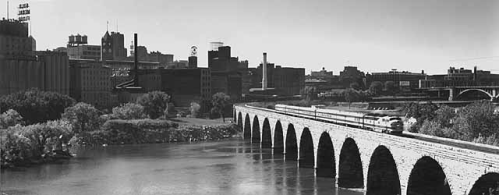Article by Michael Rainville, Jr.
 Church of the Immaculate Conception, 1875Towering over Hennepin and Lyndale Avenues, the Basilica of St. Mary has been an integral institution in Minneapolis for over 100 years. Whether you’re strolling through the Sculpture Garden or cruising north on I-94, it’s hard to miss the grandeur of this Beaux-Arts Basilica.
Church of the Immaculate Conception, 1875Towering over Hennepin and Lyndale Avenues, the Basilica of St. Mary has been an integral institution in Minneapolis for over 100 years. Whether you’re strolling through the Sculpture Garden or cruising north on I-94, it’s hard to miss the grandeur of this Beaux-Arts Basilica.
The story of St. Mary’s starts before the first cornerstone was laid. In 1868, Minneapolis’ first Catholic church was established at Third Avenue North and Third Street and was given the name the Church of the Immaculate Conception. The building was simple to put it nicely; some called it a shed. Soon after in 1873, a new building was constructed at the same spot under the leadership of Rev. James McGolrick, who later served as the first bishop of the Diocese of Duluth after his tenure in Minneapolis. This new church was built in the Gothic Revival style of architecture and served the community for over thirty years.
As the church and its parishioners were growing, so were the city’s industries. The warehouse district began encroaching on the church and by the 1890s, it became clear that a new, less industrial location was a must.
 1911 photo of the Basilica under construction.At the turn of the century, Archbishop John Ireland began planning to build two large new churches for the growing Catholic communities of Minneapolis and Saint Paul. In 1904, Ireland attended the World’s Fair in St. Louis, Missouri and was greatly impressed by its architecture. Ireland got in touch with the lead architect of the World’s Fair, Emmanuel Masqueray, and convinced him to come to the Twin Cities. Ireland’s and Masqueray’s plans were to build a cathedral in Saint Paul and a pro-cathedral in Minneapolis. For this case, a “pro-cathedral” is a temporary co-cathedral. In other words, both locations were the main churches of the Diocese of Saint Paul.
1911 photo of the Basilica under construction.At the turn of the century, Archbishop John Ireland began planning to build two large new churches for the growing Catholic communities of Minneapolis and Saint Paul. In 1904, Ireland attended the World’s Fair in St. Louis, Missouri and was greatly impressed by its architecture. Ireland got in touch with the lead architect of the World’s Fair, Emmanuel Masqueray, and convinced him to come to the Twin Cities. Ireland’s and Masqueray’s plans were to build a cathedral in Saint Paul and a pro-cathedral in Minneapolis. For this case, a “pro-cathedral” is a temporary co-cathedral. In other words, both locations were the main churches of the Diocese of Saint Paul.
Now that Archbishop Ireland had his architect, he needed to find land in Minneapolis. In 1905, Lawrence Donaldson, one half of the Donaldson brothers who started the famed department store, and parishioner of the Church of the Immaculate Conception, donated one-block of land worth $40,000, or roughly $1.25M after inflation. This location was ideal for the new pro-cathedral as it sat on the city’s main thoroughfare, Hennepin Avenue, and was in close proximity to downtown, Loring Park, and many neighborhoods.
Emmanuel Masqueray and his crew began work on the foundation in 1907 and the cornerstone was laid on May 31st, 1908, with 20,000 citizens in attendance. The building’s exterior of Rockville granite, Vermont granite, and copper was completed in 1913. The barrel-vaulted nave reaches a height of eighty-two feet, which is two feet taller than St. Peter’s Basilica in the Vatican. That same year, a school for the new church opened on the back half of the property along Laurel Avenue. The school closed in 1975.
 Photo of a baseball game being played at The Parade Grounds with the Basilica in the background, circa late 1910s.
Photo of a baseball game being played at The Parade Grounds with the Basilica in the background, circa late 1910s.
With the Baroque exterior completed, the first Mass was celebrated on May 31st, 1914, and the building’s dedication was on August 15th, 1915. Once the United States entered World War I in April of 1917, work on the interior of the pro-cathedral stopped and the school turned into a Red Cross center. Just a month later, Emmanuel Masqueray passed away and the interior work was completed by his former assistants Frederick Slifer and Frank Abrahamson. Over a year later, Archbishop Ireland also passed away and was succeeded by Archbishop Austin Dowling.
Under this new leadership, the interior was completed and consisted of a marble altar and baldacchino, a wrought iron grille around the sanctuary, sculptures of the Twelve Apostles, elaborate stained glass windows, and an organ to list a few of the features.
With the exterior and interior now complete, the pro-cathedral was given the honor of becoming the first basilica in America in 1926 when Pope Pius XI raised its rank to a minor basilica, and it became known as the Basilica of St. Mary of Minneapolis. In 1930, a celebration was held to honor the 250th anniversary of Father Louis Hennepin becoming the first non-Native American to see Owamni, or St. Anthony Falls. A statue of Fr. Hennepin was placed in front of the Basilica along Hennepin Avenue with the statue facing St. Anthony Falls.
 Postcard of the Basilica from 1930
Postcard of the Basilica from 1930
During World War II, the Basilica once again did what they could to hep the war effort, this time by making garments and surgical clothing and helping with hospital work. Between the two world wars, 1,147 male and female parishioners served in the U.S. military. After World War II, two white silk ciborium covers were made from a parachute that fell in Belgium during the war. In the Catholic Mass, ciboria hold the hosts and are the counterpart of the chalice. In 1954, the final structural piece of the Basilica was added when eight double bronze doors cast by the Flour City Ornamental Iron Company of Minneapolis were installed.
The 1960s was a decade of highs and lows. On July 11th, 1966, Pope Paul VI changed the name of the Diocese of Saint Paul to the Archdiocese of Saint Paul and Minneapolis, as it is known as today, and the Basilica was officially designated as a co-cathedral. Also in the 1960s, freeway expansion wreaked havoc in Minneapolis and Saint Paul. Interstate 94 fragmented the Basilica’s surrounding neighborhood, tearing down homes, and its close proximity would later cause major damage to the building because of the vibrations. Between that and the constant pollution and noise, the neighborhood suffered greatly. This also played a role in the school’s closing in 1975.
 Photo of I-94 construction with the Basilica in the background, 1968
Photo of I-94 construction with the Basilica in the background, 1968
Although the school had to close, that same year, the Basilica was put on the National Register of Historic Places for its exceptional Baroque architecture, its role in Catholicism in Minnesota, and its designation as the first basilica in America. Now that the building is protected historically, much needed repairs and renovations were pushed to the front of the to-do list. The copper dome and ceiling were replaced in 1992 and structural changes were made to allow better distribution of weight throughout the building.
One of the ways the Basilica raised money for repairs was the creation of the Basilica Block Party, with the first one held in July of 1994. I-94 splintered the community, and this was a way for the Basilica to reconnect the surrounding area. While a rock concert at a church was controversial to some of the parishioners, it turned out to be an amazing yearly event for the community and has grown to attract top local and national acts such as Weezer, The Jayhawks, the Goo Goo Dolls, Father John Misty, and Kacey Musgraves. The Basilica Block Party took a break in 2020 for the pandemic, returned in 2021, and is taking 2022 off to rethink what the event should be.
 Modern photo of the Basilica's interior
Modern photo of the Basilica's interior
From a purely architectural standpoint, the Basilica of St. Mary is awe-inspiring to say the least, and the parish and its parishioners have worked tirelessly to build and re-connect a severed community throughout the years, from the world wars to the expansion of the interstate highway system. The Basilica of St. Mary is more than just the first basilica in America, it’s a fixture of the community.
- - - - - - - - - - - - - - - - - - - - - - - - - - - - - - - - - - - - - - -
 About Michael Rainville, Jr.
About Michael Rainville, Jr.
A 6th generation Minneapolitan, Michael Rainville, Jr. received his B.A. in History, Graduate Certificate in Museum Studies, and M.A. in Art History from the University of St. Thomas.
Michael is a historical interpreter at the Minnesota History Center and has been a lead guide at Mobile Entertainment LLC, giving Segway, walking, and biking tours of the Minneapolis riverfront for 9+ years.
 Thursday, March 3, 2022 at 4:25AM |
Thursday, March 3, 2022 at 4:25AM |  Kim Eslinger |
Kim Eslinger | 















